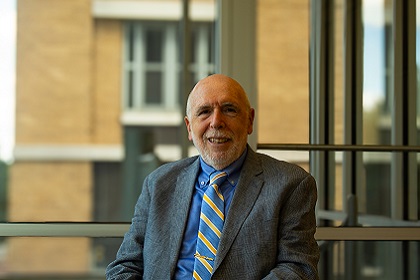Learn to lead effectively.
Public administrators in government and nonprofit organizations must keep reinventing themselves to meet the new challenges of a changing society; our 36 to 39-credit* Master of Public Administration program trains you to do just that. (*The 3-credit internship requirement may be waived by the program director for those with pertinent experience.)
 This program was the first in the state to be fully accredited by the National Association of Schools of Public Affairs and Administration (NASPAA). See the NASPAA Member Code of Good Practice.
This program was the first in the state to be fully accredited by the National Association of Schools of Public Affairs and Administration (NASPAA). See the NASPAA Member Code of Good Practice.
Program Requirements
36 to 39-credit program (3 credit internship may be waived for those with pertinent experience). Learn more
Application Deadlines
Fall: Rolling; Spring: Dec. 1; Summer: April 1. See the admission requirements
Flexible Options
Fully accredited online program, or convenient evening and online classes offered at the University of Baltimore campus in Baltimore and at the Universities at Shady Grove campus in Rockville, Md.. Dual J.D./M.P.A. is also available.
You Can Afford UBalt
Program Costs
See tuition and fees. Online MPA students and regional residents pay the in-state rate.
Scholarships
If you are an incoming graduate student, we’ll automatically consider you for merit scholarships. For more information, speak with a graduate admission counselor.
Graduate Assistantships
A graduate assistantship can help fund all or part of your tuition, and you'll gain academic, professional or research experience while working on campus and making progress toward your graduate degree or certificate.
Among the best in the country.

The University of Baltimore's College of Public Affairs is ranked in the 2024 edition of U.S. News and World Report's Best Graduate Schools, for best graduate schools in public affairs.
You will reflect critically on the role of public administration in a democratic society, the role you can play in applying our constitution and what your civic responsibilities are, as a public servant. You can choose from among six specializations:
- public policy and administration
- health-care policy and administration
- budgeting and fiscal administration
- negotiations and conflict management
- global affairs and human security
- public and nonprofit management.
You will also enhance your skills in research methods and quantitative techniques.
If you have not worked in the public sector, you can gain valuable experience through an internship or through a limited number of fully funded fellowships at UBalt's Schaefer Center for Public Policy, the research and consulting arm of the College of Public Affairs. Your work might involve program evaluation and analysis, opinion research, strategic planning, performance measurement or management training.
You are strongly encouraged to participate in American Society for Public Administration activities and in are invited to apply for membership in UBalt's chapter of Pi Alpha Alpha, an honorary public administration society for those who have achieved academic excellence.
Michael Raup, Jr., M.P.A. student
 "The M.P.A. program is about reinventing oneself to adapt to the needs of an ever-changing interconnected world. I believe this is a key differentiator of UBalt's program compared to other M.P.A. programs in the area, including those in Washington, D.C. Learning how to innovate myself to become an effective leader in the future is one reason why I decided to attend The University of Baltimore."
"The M.P.A. program is about reinventing oneself to adapt to the needs of an ever-changing interconnected world. I believe this is a key differentiator of UBalt's program compared to other M.P.A. programs in the area, including those in Washington, D.C. Learning how to innovate myself to become an effective leader in the future is one reason why I decided to attend The University of Baltimore."
Emmanuel Welsh, M.P.A. '16, Appointed Board of Public Works Executive for Governor Moore
 Emmanuel Welsh, M.P.A. ’16, was recently appointed board of public works executive for Maryland Governor Wes Moore. Welsh previously served as chief of staff, deputy chief of staff and senior advisor to former state comptroller, Peter Franchot. Welsh is also a former Schaefer Center for Public Policy Fellow, and now serves on the Center’s advisory board.
Emmanuel Welsh, M.P.A. ’16, was recently appointed board of public works executive for Maryland Governor Wes Moore. Welsh previously served as chief of staff, deputy chief of staff and senior advisor to former state comptroller, Peter Franchot. Welsh is also a former Schaefer Center for Public Policy Fellow, and now serves on the Center’s advisory board.
Denisha Hobbs, M.P.A. '21
Enrolling in The University of Baltimore's M.P.A. program opened many doors for Denisha Hobbs, such as the opportunity to participate in the Community Development Fellowship Program.
Graduation Rates
Graduation Rates, New Students Enrolled in the Fall 2017 or Spring 2018 Semesters
| Initially Enrolled | Graduated within Two Years | Graduated within Three Years | Graduated within Four Years | Total Students Graduated and Persisting to Graduation | |
| Total Number of Students in the ARY-5 Cohort | 97 | 2 | 26 | 52 | 53 |
Graduation Rates, New Students Enrolled in the Fall 2016 or Spring 2017 Semesters
| Initially Enrolled | Graduated within Two Years | Graduated within Three Years | Graduated within Four Years | Total Students Graduated and Persisting to Graduation | |
| Total Number of Students in the ARY-5 Cohort | 113 | 1 | 28 | 25 | 62 |
Graduation Rates, New Students Enrolled in the Fall 2015 or Spring 2016 Semesters
| Initially Enrolled | Graduated within Two Years | Graduated within Three Years | Graduated within Four Years | Total Students Graduated and Persisting to Graduation | |
| Total Number of Students in the ARY-5 Cohort | 112 | 10 | 32 | 46 | 49 |
Graduation Rates, New Students Enrolled in the Fall 2014 or Spring 2015 Semesters
| Initially Enrolled | Graduated within Two Years | Graduated within Three Years | Graduated within Four Years | Total Students Graduated and Persisting to Graduation | |
| Total Number of Students in the ARY-5 Cohort | 122 | 7 | 42 | 59 | 75 |
Data for the graduation rates were obtained from the admissions data system at the University of Baltimore. All students who had been enrolled in the M.P.A. program prior to the ARY-5 and who were then readmitted during ARY-5 were screened out of the data set (6) as were students who were admitted to the M.P.A. and changed majors since admission (5).
The lack of a GRE requirement encourages mid-career students to "try-out" graduate school if they meet the qualifications in other areas. Eleven students stayed only one semester. If these students are excluded from the graduation rate calculations change to 66.67%. Excluding the additional seven students who only took two semesters of classes raises the graduation rate to 67.56%.
Graduation Rates, New Students Enrolled in the Fall 2013 or Spring 2014 Semesters
| Initially Enrolled | Graduated within Two Years | Graduated within Three Years | Graduated within Four Years | Total Students Graduated and Persisting to Graduation | |
| Total Number of Students in the ARY-5 Cohort | 130 | 32 | 54 | 68 | 75 |
*In addition, there is one student who continues to be active in the program.
Graduation Rates, New Students Enrolled in the Fall 2012 or Spring 2013 Semesters
| Initially Enrolled | Graduated within Two Years | Graduated within Three Years | Graduated within Four Years | Total Students Graduated and Persisting to Graduation | |
| Total Number of Students in the ARY-5 Cohort | 111 | 31 | 52 | 60 | 64 |
| Percentage | 27.9% | 46.8% | 54% | 57.7% |
*In addition, four students were still active as of Nov. 2018. Graduated students plus active students have a persistence rate of 61.2%.
These data used are new students who applied for the 2013 academic year and took their first class in either the Fall 2012 or Spring 2013 semester. Under UBalt rules, students must reapply for admission if they have been out for more than two semesters. Readmitted students were excluded from this analysis. Previously reported data included the readmitted students.
M.P.A. Employment Information
Many students in the M.P.A. program are working professionals at the time of admission and are seeking to advance within their current organizations. See the following lists of employers and job titles of recent M.P.A. graduates:
University of Baltimore M.P.A. Students Employed Within the Profession, 2021-22
| Sector | Number of Students |
| National of central government in the same country as the program | 3 |
| State, provincial or regional government in the same country as the program | 3 |
| City, county or other local government in the same country as the program | 3 |
| Government not in the same country as the program (all levels) or international quasi-governmental | 0 |
| Nonprofit, domestic-oriented | 9 |
| Nonprofit/NGOs, internationally-oriented | 0 |
| Private sector—research/consulting | 5 |
| Private sector, but not research/consulting | 2 |
| Obtaining further education | 0 |
| Military service | 0 |
| Unemployed (not seeking employment) | 0 |
| Unemployed (seeking employment) | 1 |
| Status unknown | 16 |
| TOTAL | 42 |
University of Baltimore M.P.A. Students Employed Within the Profession, 2020-21
| Sector | Number of Students |
| National of central government in the same country as the program | 5 |
| State, provincial or regional government in the same country as the program | 5 |
| City, county or other local government in the same country as the program | 9 |
| Government not in the same country as the program (all levels) or international quasi-governmental | 0 |
| Nonprofit, domestic-oriented | 10 |
| Nonprofit/NGOs, internationally-oriented | 1 |
| Private sector—research/consulting | 1 |
| Private sector, but not research/consulting | 9 |
| Status unknown | 21 |
| TOTAL | 61 |
University of Baltimore M.P.A. Students Employed Within the Profession, 2019-20
| Sector | Number of Students |
| National of central government in the same country as the program | 4 |
| State, provincial or regional government in the same country as the program | 6 |
| City, county or other local government in the same country as the program | 10 |
| Government not in the same country as the program (all levels) or international quasi-governmental | 2 |
| Nonprofit, domestic-oriented | 11 |
| Private sector, but not research/consulting | 6 |
| Status unknown | 14 |
| TOTAL | 53 |
- fall 2018/spring 2019
- fall 2017/spring 2018
- fall 2016/spring 2017
- fall 2015/spring 2016
- fall 2014/spring 2015
For more information about graduate admission, please contact the Office of Admission at gradadmission@ubalt.edu or 410.837.6565.


